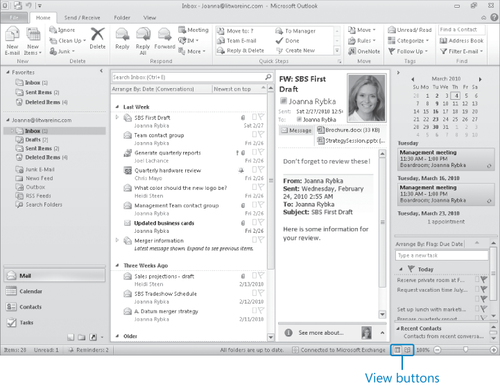The Mail module is displayed by default when you start Outlook or when you click Mail in the Navigation Pane.
The Outlook program window displaying the Mail module in Normal view.

1. Navigation Pane Content
In the Mail module, the
Navigation Pane displays the Favorites list and the folder structure of
your mailbox (or mailboxes, if you have set up multiple e-mail
accounts). When you connect to any type of e-mail account, these four
folders are visible in your mailbox:
Inbox Outlook delivers new messages to this folder.
Sent Items When you send a message, Outlook stores a copy of it in this folder.
Deleted Items
Outlook items that you delete from other folders are held in this
folder. They are not deleted permanently until you empty the folder.
Junk E-mail Outlook delivers messages blocked by the spam filter to this folder.
Tip:
You can add any mailbox folder to the Favorites
list by right-clicking the folder and then clicking Add To Favorites.
If you're managing several e-mail accounts in Outlook, you might find it
convenient and efficient to add the Inbox folders of each account to
the Favorites list so that you can work with them all in one place.
In Exchange account mailboxes, these five folders are also visible:
Drafts Outlook stores temporary copies of in-progress messages in this folder.
News Feed News feeds you subscribe to are available from this folder.
Outbox Outlook holds outgoing messages in this folder while establishing a connection to your mail server.
RSS Feeds
Web site information feeds you subscribe to are available from this
folder. When you first start Outlook, you might find information feeds
recommended by Microsoft here.
Search Folders These folders contain up-to-date results of searches you've conducted for messages that match specific search criteria.
In every module, the area at the
bottom of the Navigation Pane displays module buttons and Navigation
Pane management commands. You can change the size of the buttons in this
area by dragging the resize bar that appears above the Mail button.
If you click the Folder List button at the bottom of the Navigation Pane, these seven additional folders appear in Exchange account mailboxes:
Calendar The Outlook Calendar module
Contacts The Outlook Contacts module
Journal The Outlook Journal module
Notes The Outlook Notes module
Suggested Contacts A list of e-mail addresses with which you've recently corresponded that are not in your primary address book
Sync Issues A list of conflicts and communication failures on your mail server or in your mailbox
Tasks The Outlook Tasks module
Note:
Keyboard Shortcut Press Ctrl+6 to display the expanded folder list in the Navigation Pane.
2. Mail Module Views
We refer to the center pane that displays content in the Mail module as the Mail pane. The Mail pane displays the messages in your Inbox or other selected mail folder as well as the Reading Pane, which displays the content of the selected message.
There are two standard Mail module views:
Normal In this view, the Navigation Pane and To-Do Bar are maximized.
Reading In this view, the Navigation Pane, To-Do Bar, and ribbon are minimized.
You switch between views by clicking the View button you want on the status bar.
3. The Ribbon
The ribbon in the Mail module includes the File tab and four tabs that appear in all modules:
Home This tab includes commands you need to create and manage e-mail messages (but not message content).
The Home tab of the Mail module ribbon.

Send/Receive
This tab includes commands for synchronizing data in Outlook with data
on your mail server. You can control the sending and receiving of
messages, whether Outlook automatically downloads full messages or only
message headers, and manual download processes. You can also choose to
disconnect Outlook from the active Internet connection if you want to work offline; for example, to halt incoming and outgoing messages for a period of time.
The Send/Receive tab of the Mail module ribbon.

Folder This tab includes commands for creating and managing
folders in which you can store messages, calendar items, contact
records, notes, tasks, and other Outlook items, as well as Search
Folders in which you can display up-to-date collections of messages that
meet specific criteria. You can manage the contents of the folder and
recover inadvertently deleted items; add a folder to the Favorites list;
and control archive settings, folder access permissions, and the folder
properties.
The Folder tab of the Mail module ribbon.

View This tab includes commands for changing the way items are displayed in the content
pane; displaying, hiding or changing the location of program window
panes; and opening or closing secondary program windows.
The View tab of the Mail module ribbon.
